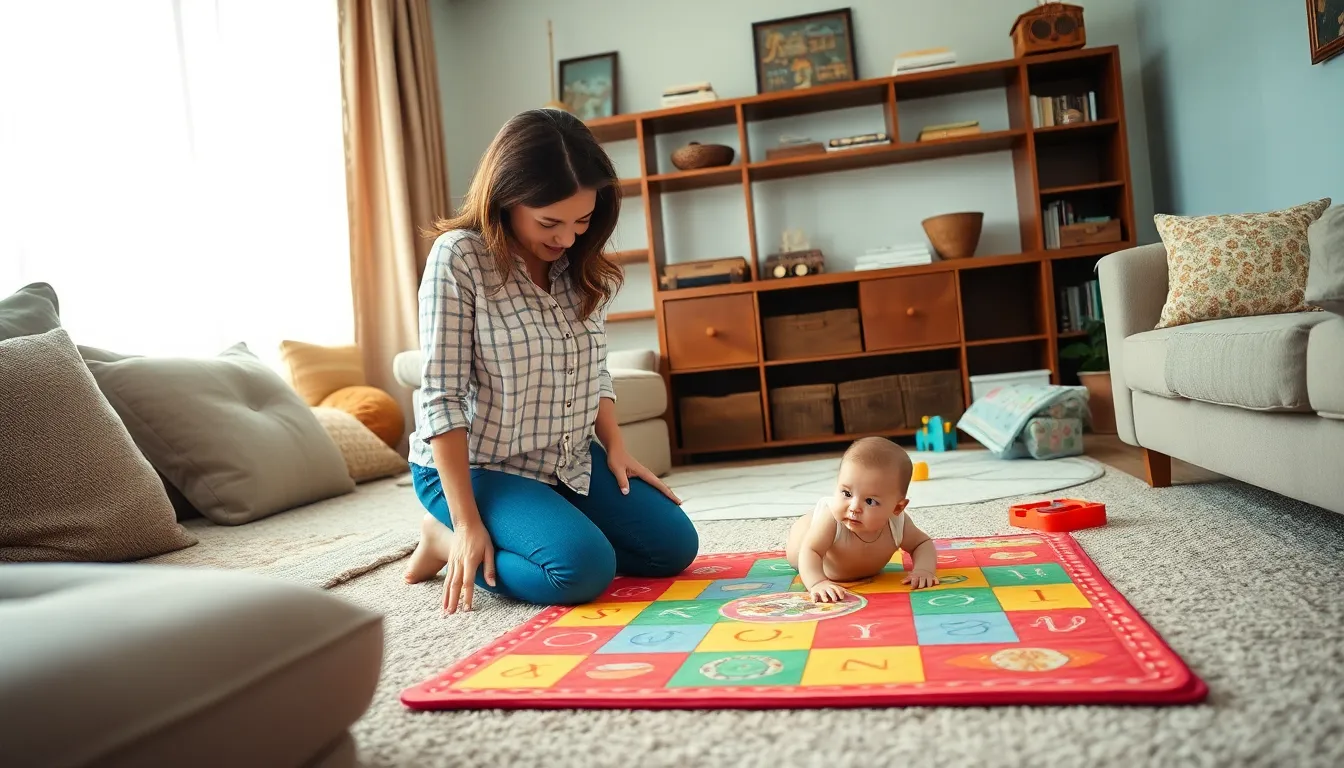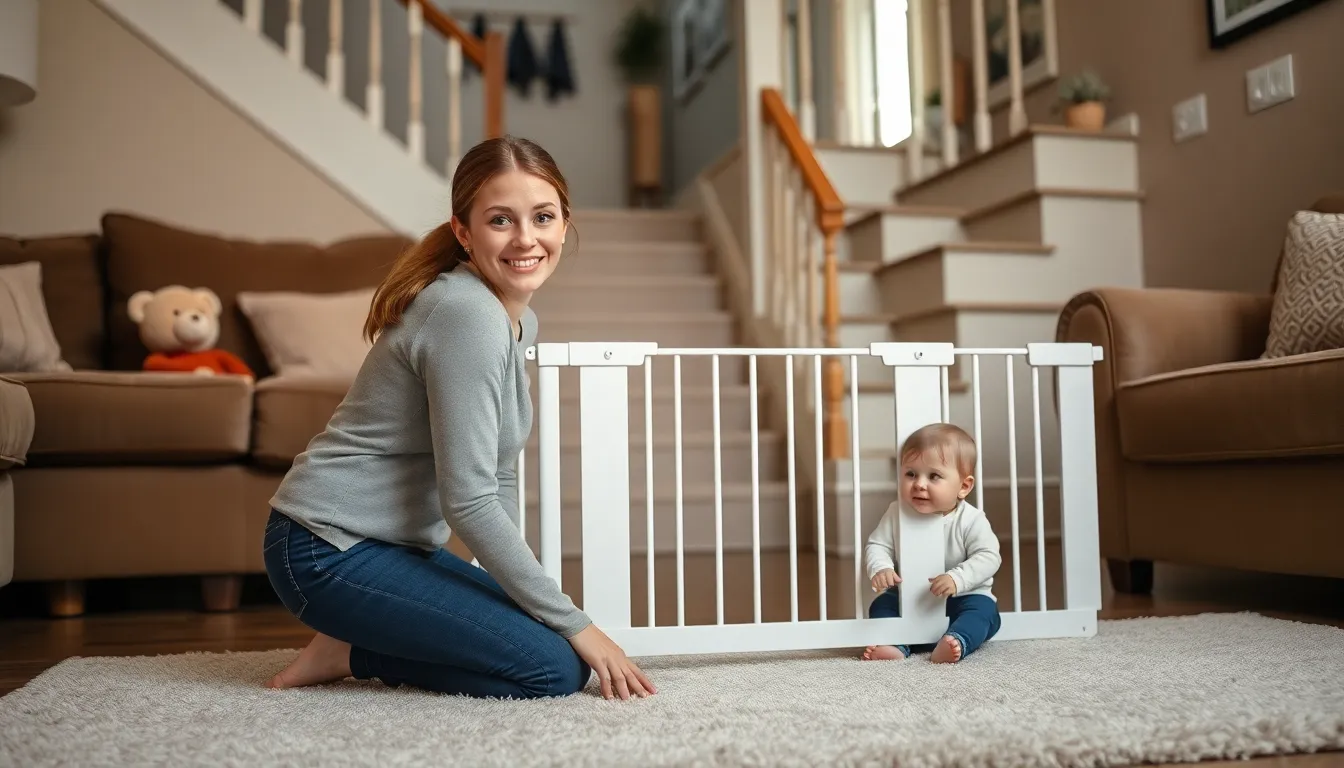Bringing a baby into the world is like inviting a tiny tornado into your home. Suddenly, coffee tables transform into climbing walls and electrical outlets become mysterious portals to danger. Babyproofing isn’t just a suggestion; it’s an essential mission that every parent must embark on.
Table of Contents
ToggleUnderstanding Babyproofing Home
Babyproofing transforms a home into a safe haven for infants. Addressing risks and creating a secure environment helps ensure the well-being of a child.
Importance of Babyproofing
Babyproofing plays a crucial role in child safety. Preventing accidents protects young explorers from potential injuries at home. Research shows that 2.5 million children sustain injuries each year due to unsafe environments. Parents can significantly reduce these risks with simple precautions. Installing safety gates, securing furniture, and covering sharp edges represents essential steps. Each measure taken fosters peace of mind for caregivers as kids navigate their surroundings.
Common Hazards in the Home
Common hazards lurk in everyday settings. Climbing furniture represents a primary risk, as toddlers find themselves tempted to explore heights. Electrical outlets pose another danger, often sparking curiosity and leading to accidents. Small objects that could pose choking risks frequently end up scattered across living spaces. Cords from appliances or blinds can entangle curious little ones, leading to serious hazards. Sharp kitchen tools and heavy items placed within reach also require careful management to prevent injuries. Identifying and addressing these dangers helps maintain a safer home environment.
Key Areas to Focus On

Ensuring safety in key areas prevents accidents and injuries in a home with an infant. Parents should prioritize the following essential spaces.
Living Room Safety
Living rooms often contain furniture that poses tipping hazards. Secure shelves and bookcases to the wall to prevent falls. Using corner protectors on sharp furniture edges lowers the risk of cuts. Additionally, avoid keeping small items on low tables, as these can be choking hazards. Cords from electronics should remain out of reach to reduce tripping risks. Making these adjustments fosters a safer play environment for babies.
Kitchen Precautions
Kitchens present unique dangers for infants. Store sharp utensils and hazardous cleaning supplies in locked cabinets to prevent access. Installing childproof latches adds an extra layer of safety. Hot surfaces and stovetops require vigilance, so using rear burners helps keep pots and pans out of reach. Additionally, ensure that small appliances are unplugged and stored safely. These kitchen precautions significantly decrease the likelihood of accidents.
Bathroom Considerations
Bathrooms contain slip hazards and potentially harmful substances. Placing non-slip mats in the tub or shower area provides extra grip. Utilize toilet locks to prevent toddlers from falling in or accessing the bowl. Store medications and personal care products in high cabinets to keep them out of sight and reach. Furthermore, keeping the bathroom door closed curbs unauthorized access during unsupervised moments. Maintaining these safety measures contributes to a safer bathroom environment.
Bedroom Safety Tips
Bedrooms present several safety challenges, particularly with cribs and furniture. Placing the crib away from windows and heavy furniture prevents potential hazards from falls or objects. Avoid using pillows or stuffed animals in the crib for infants under one year to reduce suffocation risks. Ensuring that changing tables and dressers are secure also helps protect children. Using baby gates at doorways further prevents infants from wandering while sleeping. These tips support a more secure bedroom environment.
Essential Babyproofing Products
Parents must equip their homes with essential babyproofing products to create a safe environment for infants. By focusing on specific items, safety increases significantly.
Safety Gates
Safety gates create barriers that prevent infants from accessing hazardous areas. Install these gates at stairways and in doorways, ensuring they fit securely. Choose gates that meet safety standards, such as those certified by the American Society for Testing and Materials (ASTM). Some models feature one-handed operation for caregiver convenience while restricting access to children. Regularly check the installation to guarantee it remains stable and functional.
Outlet Covers
Outlet covers protect infants from electrical shocks by blocking access to outlets. Use childproof covers, which fit snugly over outlets, making it difficult for small hands to remove them. Consider sliding outlet covers for areas with frequent use to maintain accessibility for adults while ensuring safety for children. Regular inspections of outlet covers help maintain their integrity and effectiveness. By addressing electrical hazards, parents significantly reduce the risk of accidents in the home.
Cabinet Locks
Cabinet locks prevent children from accessing dangerous items stored in kitchen and bathroom cabinets. Install locks on lower cabinets where cleaning supplies, sharp utensils, and medications are kept. Opt for easy-to-use latch designs that adults can operate quickly but are complex enough to thwart curious toddlers. Adhesive locks provide a damage-free solution for renters. Regular checks ensure that locks remain functional and secure as children grow and explore their environments.
DIY Babyproofing Solutions
Creating a safer home for a baby can involve simple, effective fixes. Parents can address hazards quickly with a few do-it-yourself methods.
Quick Fixes for Safety
Start by securing furniture to walls. This prevents tipping accidents, especially with bookshelves and dressers. Use corner protectors to shield sharp edges on tables and counters, eliminating potential injuries. Cover unused outlets with outlet covers; they block access to electrical points. If cords pose a strangulation risk, secure them with clips to keep them out of reach. Finally, place non-slip mats in high-traffic areas to reduce slip hazards and enhance stability.
Cost-Effective Strategies
Repurpose household items for safety. For example, use a tension rod under the sink to hang cleaning supplies out of reach. Install door knob covers to prevent little hands from opening doors. Create a barrier using furniture to limit access to dangerous areas, like stairs. Minimize choking hazards by regularly checking toy boxes for small pieces. These strategies help maintain a safe environment without significant financial investment.
Creating a safe home for a baby is an ongoing commitment that requires vigilance and proactive measures. By addressing potential hazards and implementing effective babyproofing strategies parents can significantly reduce the risk of injuries. Investing in essential safety products and adopting simple DIY solutions not only enhances safety but also provides peace of mind.
As children grow and explore their surroundings it’s crucial to regularly reassess the home environment. This ensures that safety measures remain effective and relevant. Ultimately a well-babyproofed home fosters a nurturing space where children can thrive and parents can relax knowing their little ones are protected.




